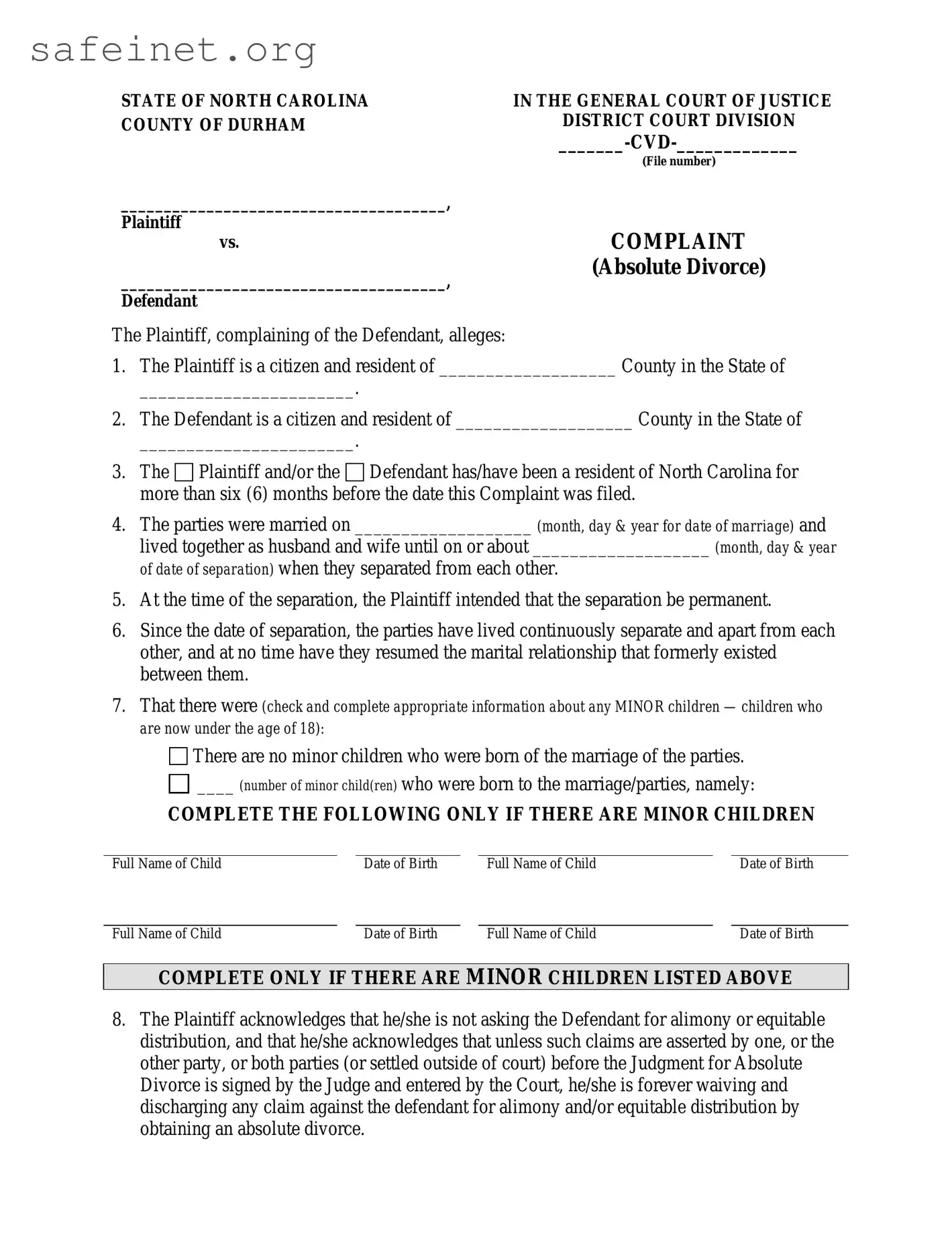STATE OF NORTH CAROLINA |
IN THE GENERAL COURT OF JUSTICE |
COUNTY OF DURHAM |
DISTRICT COURT DIVISION |
|
_______-CVD-_____________ |
|
(File number) |
______________________________________,
Plaintiff
vs.
______________________________________,
Defendant
COMPLAINT
(Absolute Divorce)
The Plaintiff, complaining of the Defendant, alleges:
1.The Plaintiff is a citizen and resident of ___________________ County in the State of
_______________________.
2.The Defendant is a citizen and resident of ___________________ County in the State of
_______________________.
3.The  Plaintiff and/or the
Plaintiff and/or the  Defendant has/have been a resident of North Carolina for more than six (6) months before the date this Complaint was filed.
Defendant has/have been a resident of North Carolina for more than six (6) months before the date this Complaint was filed.
4.The parties were married on ___________________ (month, day & year for date of marriage) and lived together as husband and wife until on or about ___________________ (month, day & year of date of separation) when they separated from each other.
5.At the time of the separation, the Plaintiff intended that the separation be permanent.
6.Since the date of separation, the parties have lived continuously separate and apart from each other, and at no time have they resumed the marital relationship that formerly existed between them.
7.That there were (check and complete appropriate information about any MINOR children — children who
are now under the age of 18):

 There are no minor children who were born of the marriage of the parties.
There are no minor children who were born of the marriage of the parties.
____ (number of minor child(ren) who were born to the marriage/parties, namely:
COMPLETE THE FOLLOWING ONLY IF THERE ARE MINOR CHILDREN
Full Name of Child |
Date of Birth |
Full Name of Child |
Date of Birth |
Full Name of Child |
Date of Birth |
Full Name of Child |
Date of Birth |
COMPLETE ONLY IF THERE ARE MINOR CHILDREN LISTED ABOVE
8.The Plaintiff acknowledges that he/she is not asking the Defendant for alimony or equitable distribution, and that he/she acknowledges that unless such claims are asserted by one, or the other party, or both parties (or settled outside of court) before the Judgment for Absolute Divorce is signed by the Judge and entered by the Court, he/she is forever waiving and discharging any claim against the defendant for alimony and/or equitable distribution by obtaining an absolute divorce.
9. (check if applicable) That the Plaintiff and Defendant executed an agreement settling property and other issues on _____________. (attach a copy of the agreement)
(check if applicable) That the Plaintiff and Defendant executed an agreement settling property and other issues on _____________. (attach a copy of the agreement)
10. (check if applicable) That the Plaintiff be allowed to resume the use of her maiden name, to wit: __________________________ (print maiden name).
(check if applicable) That the Plaintiff be allowed to resume the use of her maiden name, to wit: __________________________ (print maiden name).
WHEREFORE, the Plaintiff respectfully requests the following:
1.That the bonds of matrimony which have existed between the parties will be dissolved and that he/she be granted an absolute divorce from the Defendant.
2.The Plaintiff respectfully requests that the Separation and Property Settlement Agreement executed by the parties on ______________ be incorporated herein.
This the _____ day of _________________, 20_____ (month and year).
________________________________________
(Plaintiff’s full name--SIGNATURE)
_____________________________________________________
(Complete street/mailing address of Plaintiff)
________________________________________
________________________________________
(City, State, Zip Code for Plaintiff)
________________________________________
(Plaintiff’s Telephone number)
VERIFICATION
(Must be signed in front of a Notary Public)
I, ______________________________________ (Print Your Name), being first duly sworn,
deposes and says that I am the Plaintiff herein, that I have read the foregoing Complaint for Absolute Divorce and know the statements therein to be true of my own personal knowledge, except as to those matters alleged upon information and belief, and as to those matters, I believe them to be true.
This _____ day of _____________, 20____ (month and year).
__________________________________________________
(Plaintiff’s SIGNATURE—FULL NAME)
Subscribed and affirmed before me this ____ day
of ________________, 20____.
____________________________
Notary Public
My Commission expires: ______________


 Plaintiff and/or the
Plaintiff and/or the  Defendant has/have been a resident of North Carolina for more than six (6) months before the date this Complaint was filed.
Defendant has/have been a resident of North Carolina for more than six (6) months before the date this Complaint was filed.
 There are no minor children who were born of the marriage of the parties.
There are no minor children who were born of the marriage of the parties.

